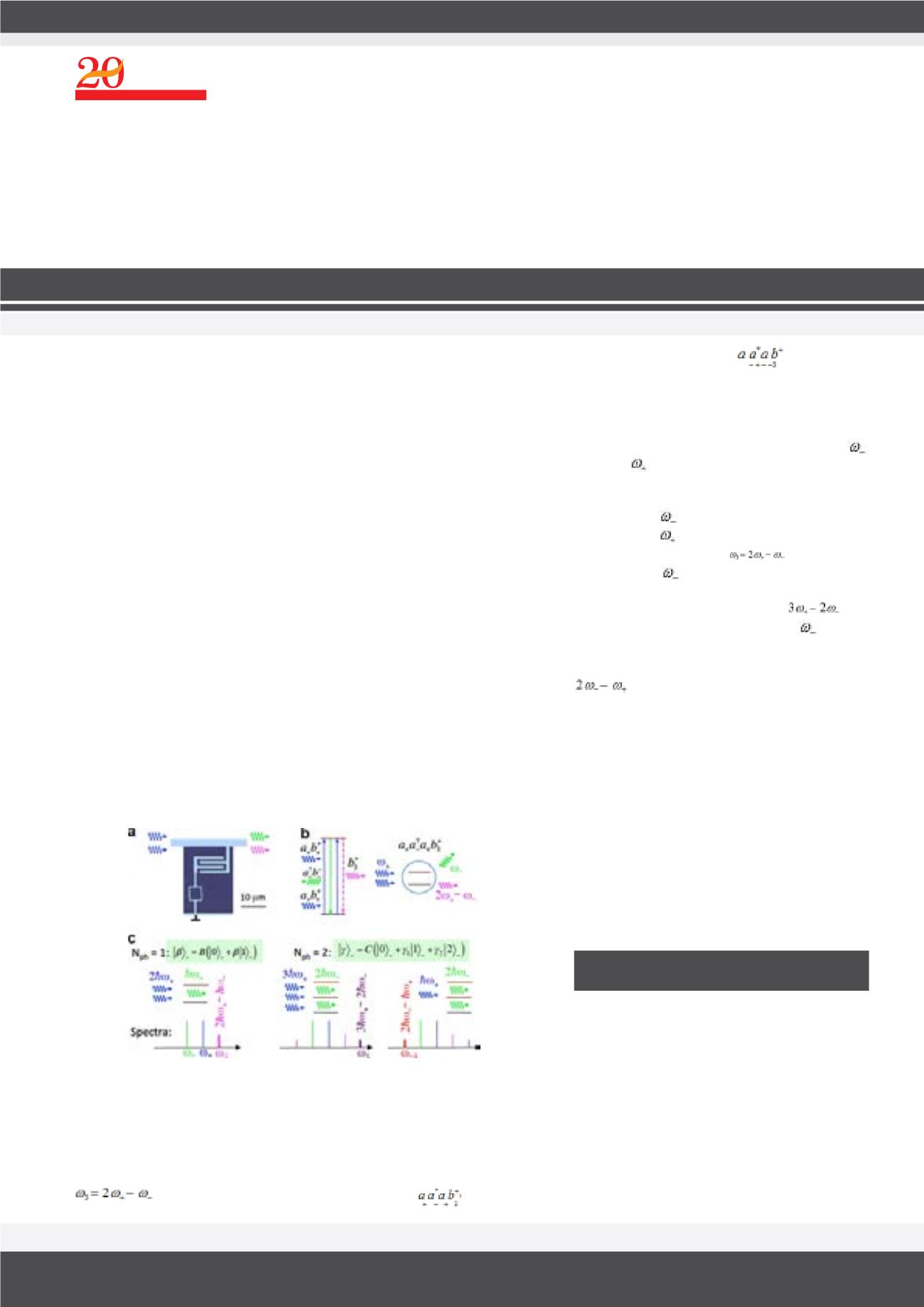

Page 49
N o v e m b e r 0 5 - 0 6 , 2 0 1 8 | P h i l a d e l p h i a , U S A
3
rd
INTERNATIONAL OBESITY SUMMIT AND EXPO
&
&
DIABETES, NUTRITION, METABOLISM & MEDICARE
2
nd
International Conference on
Joint Event on
OF EXCELLENCE
IN INTERNATIONAL
MEETINGS
alliedacademies.comYEARS
LASER, OPTICS AND PHOTONICS
World Conference on
Obesity Summit 2018 & Diabetes Conference 2018 & Laser Photonics Conference 2018
Biomedical Research
|
ISSN: 0976-1683
|
Volume 29
V N Antonov et al., Biomed Res 2018, Volume 29 | DOI: 10.4066/biomedicalresearch-C7-019
PROBING OF PHOTONIC STATES IN 1D
SPACE
V N Antonov
1,3*
, T Hönigl Decrinis
1
, O V Astafiev
1,2
R Shaikhaidarov
1,3
and
A Yu Dmitriev
2
1
University of London, UK
2
Moscow Institute of Physics and Technology, Russia
3
University of London, UK
T
he wave mixing is well revealed and theoretically described phenomenon
of a nonlinear optics. It has applications in phase conjugation, genera-
tion of squeezed states, parametric frequency conversion, signal regenera-
tion schemes and exploited significantly for spectroscopic study of various
systems. The wave mixing was thoroughly investigated in a medium such
as fiber, atomic beams and vapors, with various numbers of mixed waves,
exploiting two or more levels of a system. However, any medium represents
a huge ensemble of atoms, so one needs many photons to drive the medium
efficiently. Also, energy levels are broadened in homogeneously and hence
what is accessible in wave mixing experiment is collective response of an
ensemble of atoms. QuantumWave Mixing (QWM) reveals itself as an elastic
scattering of coherent classical and non-classical photonic states of elec-
tromagnetic waves on a single atom. We show a spectrum, corresponding
to four-wave mixing of non-classical photonic states with a fingerprint of in-
teracting photon states: the number of frequency peaks due to stimulated
emission
Fig1. a) A false colored SEM image of the device: a superconducting loop with
four Josephson junctions, behaving as an artificial atom is embedded into
a transmission line and strongly interacts with propagating electromagnetic
waves.
b) Four-wave mixing processes resulting in the single-photon field creation at
. In classical mixing, the process operators
comes in pair
V N Antonov has his expertise in solid state nanophysics.
He is one of scientists who made a breakthrough in ex-
periments on quantum phenomena in low dimensional
hybrid nanostructures, like Andreev interferometer, ferro-
magnetic/superconducting systems. A single photon ter-
ahertz detector based on semiconductors quantum dot
developed in collaboration with Komiyama and Astafiev
keeps a record sensitivity and it is used in a number of
applications. A recent activity in superconducting quan-
tum circuitry, superconducting resonators of high quality
factors, and nanomagnetics is a subject of a number of
publications in high ranked journals. He is also involved in
development of the technology of high power diode laser
for communications as an expert in nanofabrication.
v.antonov@skoltech.ruBIOGRAPHY
with the symmetric one
. In the mix-
ing with non-classical states, time symmetry is
broken resulting in the asymmetric spectrum. c)
Schematic representation of QWMwith non clas-
sical coherent states and sensing of the coher-
ent quantum states. Two sequential pulses
and then
are appliedbreaking time symmetry
and, therefore, spectrum symmetry. Coherent
photonic states are created in the atom by the
first pulse at
and then mixed with the sec-
ond pulse of
. Single-photon,
N
ph
=1, state β
can only create a peak at
because only
one photon at
can be emitted from the atom.
Two photon,
N
ph
=2, coherent state γ results in
creation of an additional peak at
, be-
cause not more than two photons
can be
emitted. Also one photon of can be absorbed,
N
ph
-1, creating additional left-hand-side peak at
. Always exceeds by one the ones due
to absorption, see Fig.1. We also study four- and
higher-orderwave mixing of classical coherent
waves. In this case the time dynamics of the
peaks exhibits a series of Bessel-function quan-
tum oscillations with orders determined by the
number of interacting photons. In our study we
operate in the microwave range of electromag-
netic radiation. The two level superconducting
circuit, qubit, serves as the artificial atom which
scatter the microwave radiation, see Fig. 1. In
a wider context these artificial atoms may be a
building blocks of novel on-chip quantum elec-
tronics, which utilize the quantum nature of elec-
tromagnetic waves.


















